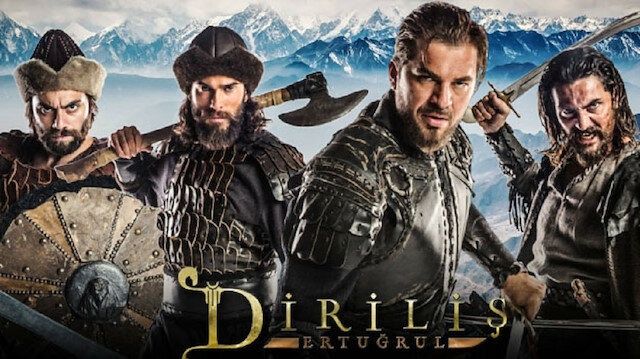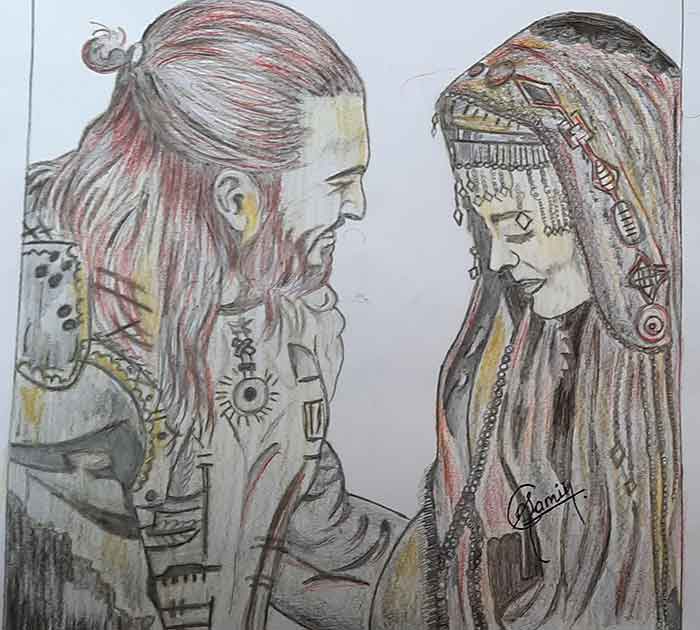Co-Written by Ishrat Mushtaq Malik, Sajad Hassan Khan, Sartaj Hafiz Rathore

Dirilis Ertugrul (Resurrection Ertugrul) is a Turkish T.V series, produced and directed by Mehmet Bozdag, which began airing on TRT1 in Turkey in December 2014. It consists of five seasons (450 episodes of 45 minutes each on Netflix). It has been dubbed in more than twenty (20) languages, including Urdu, and broadcasted in more than seventy (70) countries thus far. The gravity and popularity of the show can be gauged by the fact that the countries like U.A.E and Egypt had to ban it, and conversely, the Prime Minister of Pakistan, Imran Khan while urging his public to watch it, regarded it as an “alternative culture”.
The ex-Chairman, Professor Ali Nadeem Rezavi, of the Centre of Advanced Studies, Department of History, Aligarh Muslim University, Aligarh also suggested his students to watch the show, posting about the latter on the facebook group “the history learner.”
The show is a depicture of the history of Muslim Oguz Turks from 13th century onwards, who as a result of the Mongol invasions migrated from Central Asia. One among such tribes, the Kayis settled in Anatolia. With Ertugrul (father of Osman 1) as the main character, the show mainly features the struggles of the Kayis with Christians (Crusaders/Templars) in the West and Mongols/Tartars in the East, culminating in the establishment of the Ottoman Empire (1299-1924).
In an article published in Greater Kashmir (25-04-2020), the author very comprehensively reviewed the serial’s first season, giving an engaging description of the plot and the context, highlighting the medieval linkage of the series, the martial character of the Kayis, the strifes with Crusaders and the central role of Muslim women (as against the Orientalist stereotyping).
The second season mainly features the Mongol attacks, and the Kayis taking sanctuary with the Dodurgas (another formidable tribe and also the maternal home of Ertugrul) under the leadership of Hyma Ana (Ertugrul’s Mother), while Ertugrul is captive with the Mongols. Apart from exhibiting the domesticity, socio-political and economic institutions of the Oguz Turks, this season adds to our knowledge of the Mongols, their socio-political systems, customs, beliefs (Shamanism/Tengrism). It acquaints us with many historical figures among the Mongols like Chingez Khan, Ogedai Khan and Bayju Noyan, inciting one to know more about them. Women are not kept marginal but a good volume of central role is allotted to them with Aytolun, Goncagul on one side and Selcan, Halime and Banu Cicek on the other as opposing alliances, and Hyma Ana virtually leading the tribe. The season ends with a split in the Kayi tribe with Ertugrul, his younger brother Dundar and Hyma Ana migrating further west of Anatolia, and his two elder brothers Gundogdo and Sungurtekin Bey spreading the lineage of Sulaiman Shah (their father), in Ahlat.
The third season brings a new life for the Kayis, the path is “holy but harsher”. Ibn-al-Arabi compares the migration to that of Prophet’s (P.B.U.H) migration from Mecca to Medina. With the plot set around the Hanli Market (A Byzantine stronghold, later conquered by Ertugrul), the season chiefly depicts the wars with the Byzantine Christians. Also, a constant competition is visible within the Turkish tribes, between the Kayis and the Cavdars.
The season glimpses various Islamic laws regarding the modes of taxation, modes of warfare, distribution of war booty, and the protection of non-Muslim subjects under Ertugrul Bey. Again women are not reduced to their immediate gendered identity but are treated as potential individuals – be it Helena’s role in the Karacahisar castle or Aslihan leading the Cavdars. The season ends with the appointment of Ertugrul Bey as the “Uchh Bey”(margrave/frontier bey) by the then Sultan, Sultan Allaedin Keykubad.
The fourth season starts with the internal tensions among the Turkish tribes, with Emir Sadettin Kopek (one of the closest ministers of the Sultan) as the doyen of court intrigues. The important events covered in this season are: the conquest of Karacahisar, assassination of Sultan Allaedin, Birth of Osman 1, third son of Ertugrul and the founder of the Ottoman Empire, and execution of the vile and despicable Emir, Kopek. Towards the end, the Mongols again appear on the scene and the Kayis migrate to Sogut, further closer to the “holy war”.
By then, the Mongols had taken Crimea, Black Sea, Dasht-i-Kipchak, Danube, encompassing Anatolia from three strategic sides; thus making life harsher for the Avsars, the Kiniks, the Dodurgas and the Cavdars. Ertugrul and his descendents get the permanent possession of western Anatolia including Karacahisar, Sogut and Domanic area from the late Seljuk Sultan, Allaedin.
The Fifth season is set around Sogut, with Seljuks reduced to the vassals of Mongols (battle of Kose Dag, 1243). This season highlights Ertugrul’s astuteness in handling both the Mongol and the Christian enemies and shrewdly using them against each other. This season is the embodiment of political maturity and diplomacy as exhibited by Ertugrul Bey.
The show is carried by its sequel, Kurulus: Osman (Founder: Osman), which features the life of Osman 1, the founder of the Ottoman Empire.
Not a Turkish Game of Thrones…
Dubbing Dirilis Ertugrul (henceforth D.E) as Turkish Game of Thrones would be a sheer injustice. Firstly, the two differ in genre: while Ertugrul is based on the history of Ottoman empire, involving Muslim, Mongol and Christian histories; Game of Thrones (henceforth GoT) is an adaptation of “ A Song of Ice and Fire”- George R.R. Martin’s series of fantasy novels, set in the fictional “seven kingdoms of Westeros”. Secondly, there is a notable difference in the context and the plot of the two shows; GoT chronicles the violent dynastic struggles among different noble families for the already existing “Iron Throne”. Ertugrul, however, features the road to a new establishment.
What is less…
Although ‘D.E’ features many men of literature and skill like Ibn-al-Arabi, Dervish Ishaq, Accacakoca, Artuk Bey, Aliyar Bey, etc, but the depicture of any learning centre/library like that of GoT is missing here. Likewise, in such a long series, none of Ibn-al-Arabi’s works (like Fusus-al-Hikam, Al-Futuhat-al-Makkiya, the Diwan, Ruh-al-Quds)find any mention. But on the credit side, there is literally no nudity or obscene content in Dirilis Ertugrul, which one can find in abundance in GoT, thus making Ertugrul a virtue for eyeballs. In sum, one can enjoy watching Dirilis Ertugrul with children and family unlike GoT. Likewise, wild fantasies like flying dragons, ice wall and fanciful buildings do not figure in D. E thus making Ertugrul more realistic than GoT. Moreover, Dirilis Ertugrul does not objectify women like that of GoT; be it Denarys’ marriage to Khaal Drogo, Sansa Starks’ harassment by Ramsey Bolton, or for that matter Cerci’s incestuous relationship with her brother and her walk of shame.
What is more…
First, Unlike reducing women to their gendered identity, Dirilis Ertugrul treats women as equal individuals. The roles of Hyma Ana, Halime, Banu Cicek, Isadora, Helena, Ilbilge Hatun etc., elaborate upon the same. Aykiz’s public whipping shows that women were treated equally as their male counter parts-both in rights and duties, privileges and punishments. Hayma Ana, Halime Sultan, Banu Cicek and Aslihan, all are fine warriors apart from managing both, their houses and the tribal economy (Rug house). Aslihan quite ably headed her tribe after her family perished. Isadora, Helena (later Hafsa) and Ilbilge Hatun are righteous women who gave up their everything including their families while upholding justice and righteousness.
One thing which is striking and important to be noted in this series is the role of traitors in inflicting tyranny in a society along with their masters. How they work and proceed in their cunning ambitions is beautifully depicted in this series and the manner to deal with them is also clearly depicted.
In sum, a big contrast is visible while comparing the treatment of women in the two shows. Unlike GoT (with exceptions like Arya Stark and Brianne), the women here are not showed as weak, docile and oppressed but as strong, righteous and upright. They are depicted as healers, fighters, riders and leaders. They are expected and trained to be the women who can do the both “lay the table, and hold the sword”.
The historicity of such a depiction is doubtful. But whatever the amount of truth contained, it is quite intriguing that Muslim Women in Turkey in the 13th century were treated far better than their Indian counter parts even of the 19th and 20th centuries, where it still required a ‘palanquin’ (dholi) to carry the girl students to schools, where ‘Purda’(in an extreme rigid form) was the main obstacle to Muslim women’s education and reform.
Yes, there are “maesters” and “grand maesters” like Samwell Tarly, Pycelle, Luwin etc., some fantacy around the dragon glass (that could kill the white walkers), use of catapult and wild fire in warfare technology, but the technology is not shown as something integral to daily life in GoT. Conversely, D.E. illustrates a wider variety of technologies of the time like ‘spinning’ and ‘weaving’, ‘dyeing’ with the natural dyes, ‘iron smithery’ by (Deli Demir), ‘gold mining’ technology by (Master Hachaturyaan). A fairly well developed ‘leather work industry’ is also portrayed, with a Mongol lady, Almila Hatun, mastering the art. Besides, a ‘good deal of medicinal knowledge’ is also depicted like ‘making antidotes for deadly poisons’, ‘treating deep burns’, ‘cauterization of wounds’ and most importantly the ‘precautions taken during the epidemic black death’. Such daily life technology is lacking in GOT……..
Why a must watch…
Although watching series like ‘Drilis Ertugrul’ and ‘Kurulus Osman’ can’t suffice and offer an entire civilizational setup, as the series’ are not infallible (so made to appear by many a viewers). Yet it is understood by the fact that the fields like Literature, Art and Cinema play an illuminating role in shaping ones perceptions about various things.
Similarly, such web series can help us explore our past at a time when the whole Muslim world is in disarray and is witnessing disorganization and demoralization. It can help our generation to destroy the shackles of hopelessness, depression and anxiety; particularly the youth, addicted to drugs, online games like PubG, and media like Tik Tok (which seem more menacing than entertaining),and many other vices. They can reassert confidence and hope by watching such series. Not only this, there are productions like “Omar Series” and “Ashab-ul-Qahf” which we consider more than a necessity as of now because these have been largely successful in challenging the mainstream media view of Islam. Moreover, TV serials (much in vogue in India and Pakistan) have succeeded in proliferating the western construct of colonial mentality and also shaken the foundations of the institutions of family, marriage and kokinship- alike.
Like the proliferation of literature in Europe gave way to Renaissance, it is inevitable for those who dream for an Islamic Renaissance to read the book of revelation and revolution, the ‘Holy Quran’, that changed the Bedouin Arabs and made them the masters of a civilization. The next falling in the list is the authentic ‘Ahadith’, the traditions of the holy Prophet PBUH. The reading of Islamic history and history of the world, philosophy and other subjects like science and logic could add more to the wisdom of those who literally desire to get rid of the shackles of injustice, tyranny and misery.
Onus lies on the youth to recollect the wasted energies through Islamic literature, books, and similar web series to give an organizational vent to the frustrations and anxieties in not a sordid but positive and immaculate manner.
The authors, Ishrat Mushtaq Malik, Sajad Hassan Khan, Sartaj Hafiz Rathore, are Doctoral Candidates in Modern Indian History at Aligarh Muslim University.
SIGN UP FOR COUNTERCURRENTS DAILY NEWS LETTER












































